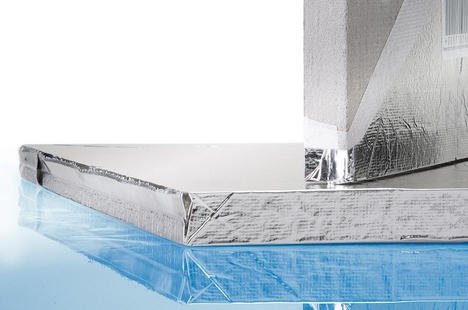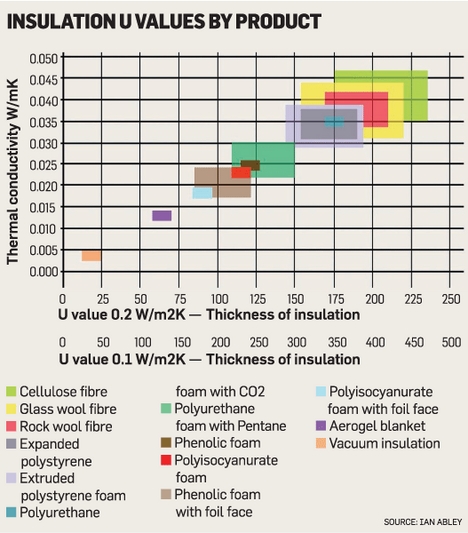
 |
|
|
#1 |
|
Supreme EcoRenovator
Join Date: Mar 2009
Location: Portland, OR
Posts: 4,004
Thanks: 303
Thanked 724 Times in 534 Posts
|
Zwerius, from the Neatherlands, is a new member of the EcoRenovator conversation.
He recently started a thread, that pointed to his site in Dutch about his successful efforts to dramatically reduce heat loss through the exterior door to his house.  His original Dutch post SHOULD_NOT_BE_MISSED and is made available in English. The secret to Zwerius' success is his use of a radical, newly-available insulation called Vacuum Panel Insulation (AKA: "VIP").  I calculated the R-value of the material he was using in Imperial units, and it is R-21.3/inch in US terms.  That makes this stuff a real game changer, which could find use in exterior doors, as Zwerius has done, also for ultra-efficient refrigerators, etc. I found some US sources of information at TOOLBASE, which gives a very good breakdown of the technology, it's virtues and weak points, primarily vulnerability to puncture. I also found THIS_SITE, which is a US company that sells VIP panels. I called the above firm just now and they are forwarding information to me and I will make it available to this thread. HERE_IS a European article from 2009 that goes into good detail, too. I did a brief preliminary search for DIY efforts regarding VIP making, and didn't locate anything in the short time I searched... but it sure would be a tremendous boon to be able to do it. More Info:Best, -AC
__________________
I'm not an HVAC technician. In fact, I'm barely even a hacker... Last edited by AC_Hacker; 09-15-14 at 01:51 PM.. |
|
|

|
|
|
#2 |
|
Master EcoRenovator
Join Date: Aug 2012
Location: Toronto
Posts: 958
Thanks: 40
Thanked 158 Times in 150 Posts
|
Here is a Dow product with an R9.8 value. I am looking for a PDF of a vacuum window I was going to buy for a job but never got to do it.
High-Performance Building Insulation Blanket - Dow Corning |
|
|

|
|
|
#4 |
|
Administrator
Join Date: Aug 2008
Location: Germantown, WI
Posts: 5,525
Thanks: 1,162
Thanked 374 Times in 305 Posts
|
Very interesting. I thought polyiso was the best insulation we had. I guess its the best readily available one.
__________________
Current project - To view links or images in signatures your post count must be 0 or greater. You currently have 0 posts. To view links or images in signatures your post count must be 0 or greater. You currently have 0 posts. & To view links or images in signatures your post count must be 0 or greater. You currently have 0 posts. |
|
|

|
|
|
#5 |
|
Supreme EcoRenovator
Join Date: Mar 2009
Location: Portland, OR
Posts: 4,004
Thanks: 303
Thanked 724 Times in 534 Posts
|
In my searching for DIY Vacuum Panel info, I came across the following video that is using vacuum insulation techniques, but in this case, it is for solar heat-loss in water piping:
Some good ideas here Best, -AC
__________________
I'm not an HVAC technician. In fact, I'm barely even a hacker... |
|
|

|
|
|
#6 |
|
Supreme EcoRenovator
Join Date: Mar 2009
Location: Portland, OR
Posts: 4,004
Thanks: 303
Thanked 724 Times in 534 Posts
|
More Vacuum Technology resources...
Here is a supplier of aluminized Mylar bags Here is an Instructable for a DIY Vacuum Chamber Sealing Machine. ...and a video of the above machine in operation... Best, -AC
__________________
I'm not an HVAC technician. In fact, I'm barely even a hacker... |
|
|

|
|
|
#7 |
|
Helper EcoRenovator
Join Date: Aug 2014
Location: The Netherlands
Posts: 70
Thanks: 19
Thanked 26 Times in 14 Posts
|
Hello Everyone,
From the previous post from AC Hacker, you might get the idea to fabricate your own VIP's. However, there are a few things you should know. First of all, you need a quite deep vacuum (<0,1 mbar or < 10Pa) and that's not so easy to achieve with standard vacuum equipment. Secondly and maybe even more important is, that mylar may be 100% impermeable for Oxygen and Nitrogen (the main components of air), but if you weld mylar parts, the seam is not 100% impermeable. So, slowly oxygen and nitrogen will leak in and reduce the vacuum. For this reason getter materials are incorporated in the inside of the closed "bag", to cath the atoms that leaked in. Another difficulty might be to get the insulation material that should be inside the bag. It needs to have very small pores. Generally fumed silica is being used. I would say, this all is beyond the capabilities of DIY. But of course you may want to try  . If so, keep us posted... . If so, keep us posted...If you want to read all the details about VIP's, I would suggest you to read these reports that I used during my study Renewable Energy Systems Technology (Loughborough University UK): http://www.ecbcs.org/docs/Ann39_2001_1_hipti_proc%20.pdf https://www.google.nl/url?sa=t&rct=j...75097201,d.ZWU http://www.ecbcs.org/docs/Annex_39_R...ubtask-A-B.pdf Despite the difficulties to fabricate this stuff it's very interesting, but expensive material. For those of you interested in advanced glazing and transparent insulation, I would recommend this link: https://www.google.nl/url?sa=t&rct=j...75097201,d.ZWU |
|
|

|
| The Following 3 Users Say Thank You to Zwerius For This Useful Post: |
|
|
#8 |
|
Supreme EcoRenovator
Join Date: Oct 2008
Location: Austin, TX
Posts: 1,154
Thanks: 14
Thanked 257 Times in 241 Posts
|
That's a vacuum level of about 75 microns, which is attainable with a good HVAC vacuum pump in good condition.
__________________
To my surprise, shortly after Naomi Wu gave me a bit of fame for making good use of solar power, Allie Moore got really jealous of her... |
|
|

|
|
|
#9 | |
|
Supreme EcoRenovator
Join Date: Mar 2009
Location: Portland, OR
Posts: 4,004
Thanks: 303
Thanked 724 Times in 534 Posts
|
Quote:
Zwerius, do you think that the phenomenon of vacuum insulation only occurs at <0.1 mbar? This would be what is known as a 'step function'. It seems to me that there would be a gradient of insulation improvement as vacuum levels became greater. For instance, a micron gauge is an instrument that is commonly used in refrigeration work to measure vacuum levels. The principle of operation is that there is a direct relationship between variation of heat flow across a variation of vacuum level. The micron gauge uses a very small heat source and a precision thermocouple is used to measure the changing heat flow as vacuum levels change. As another example, taken from Aerogel technology, is a graph taken from THIS_PAGE that illustrates this varying relationship.  My point is that a person who is working with relatively unsophisticated equipment actually can realize very useful improvements in insulation, even if they do not achieve the theoretical maximum. In short, yes I do believe that it is possible to DIY your own useful vacuum insulation. Best, -AC
__________________
I'm not an HVAC technician. In fact, I'm barely even a hacker... Last edited by AC_Hacker; 09-18-14 at 11:23 AM.. |
|
|
|

|
|
|
#10 |
|
Supreme EcoRenovator
Join Date: Mar 2009
Location: Portland, OR
Posts: 4,004
Thanks: 303
Thanked 724 Times in 534 Posts
|
Please Remove Duplicate
__________________
I'm not an HVAC technician. In fact, I'm barely even a hacker... |
|
|

|
 |
|
|